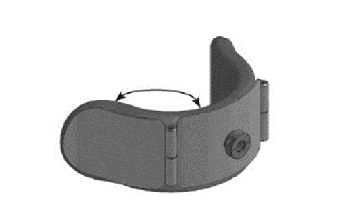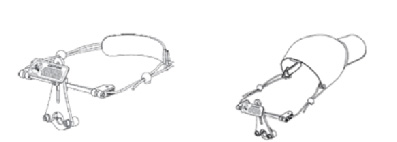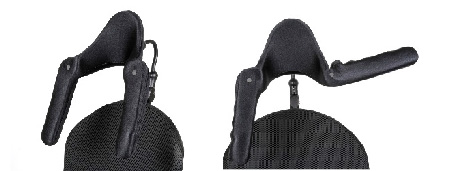Share:
Hello all!
Last month, we began our look at head supports and focused on assessment and generic choices available in mounting hardware. Click here if you missed Wheelchair Head Supports – Part 1. This month, let's continue our look at head supports and consider the choices available in pads and possible customizations.
Pads
As I mentioned in last month's article, the pad choices for head supports are numerous, and range from very simple single pad systems to multi-pad systems. The photographs below, from left to right, show single pad, contoured pad, 2 pad, 3 pad, and 5 pad systems.

Let's think about the different pad choices and when they may be most appropriate to use. A single pad has a slight curve and provides support at the occipital area. The single pads come in different lengths. As the length of the pad increases, the surface contact area and the amount of support provided also increases. Single pad systems often are used for individuals who require head support when using tilt/recline mechanisms on wheelchairs.
Some single pads have hinges in them to allow for greater lateral support of the head, as the graphic below illustrates. The hinges allow for one or both sides of the pad to be brought in closer to the head to help maintain an upright posture of the head when passive or active lateral cervical flexion is present.

A contoured pad is a single pad system that provides more support than a basic single pad. The contoured pad provides support to the occipital and sub-occipital areas, in addition to the lateral cervical spine. It is intended for a person who requires more support than a basic single pad can offer as it more closely follows the shape of the back of the head and neck.
When a contoured pad is insufficient to provide support in the required areas of the head and neck, a 2 pad system can be considered. In a 2 pad system, the support to the occipital and sub-occipital areas are separated. The sub-occipital pad is curved and can be adjusted independently of the occipital pad, which allows for improved placement of the proximal lateral cervical support for some individuals. Just as there is choice in the length of the occipital pads, there is choice in the size of the sub-occipital pads.
When head and neck asymmetries are present, the use of a 3 pad system allows for independent adjustment of each sub-occipital and occipital pad in order to maximize surface contact area and support. Since each sub-occipital pad can be rotated and moved anteriorly/posteriorly and laterally, greater proximal lateral cervical support can be achieved for those who require more aggressive positioning.
Every pad system, from the one pad to the 3 pad system, can accept the addition of lateral facial pads. For some individuals, the addition of lateral facial pads provides increased positioning of the head, such as the 5 pad system in the photo above (to the far right). It is the addition of brackets and rods that allows for the placement of pads of various sizes and shapes. See below for a graphic of the mounting hardware for the lateral facial pads.

The rods shown in the above graphics may also be used to mount switches. Switches, whether mechanical or electronic, can be added to the rods, which, for example, may enable an individual to drive a power wheelchair.(Click here for more on Specialty Controls for Power Wheelchairs.)
Anterior Support
With all seating and positioning, anterior support, such as a head strap, is the last piece of the puzzle that is considered, after all other options and positioning needs have been addressed. For example, it may be the use of gravity, such as using the tilt feature on a wheelchair, which facilitates head control for an individual who has good posterior and lateral cervical positioning through the choice of pad systems. It is only if positioning and the use of gravity does not facilitate sufficient head control that anterior supports may be considered. The graphics below, from left to right, illustrate a head positioning strap and a ball cap attached to a head positioning strap that provide examples of anterior support for the head. The ball cap is sometimes chosen as this provides a more aesthetically appealing option to having a forehead strap and sometimes is better able to stay in place.

Often head straps do not work well for individuals. Since people have different shapes to their foreheads, the positioning straps may slide off the forehead. Due to of the risk associated with the forehead straps slipping, sometimes they are applied only during specified periods; for example, only during meal times to enable good head control for eating and when others are present for safety.
Another form of anterior support is one that is shaped to provide occipital support with anterior "arms" that provide shoulder retraction, as shown in the photograph below (mounted to a firm back support).

By having anterior and lateral stabilization of the shoulders and trunk, head control is optimized. The photograph to the right shows that the stabilization arms are able to swing out, to allow for transfers in/out of the wheelchair, while maintaining the correct height of the head support.
Modifications
When we think about modifications for head supports, it's a good idea to think about the design and construction of head support pads. Just like a back support has a firm outer shell, layer(s) of foam, and an outer cover, so too does a head support pad. This means that modifications can be made to any component of the pad. For example, the aluminum shell can be bent to provide better shape for an individual, if required. The foam layers can be modified, such as by having a top layer of visco-elastic foam for immersion or by using a gel insert for reduction of shear forces. Similarly, choice is available in outer covers.
Lycra™, which is a four-way stretch material, tends to be an oft-used material for head support pad covers; however, reverse Dartex™ and fleece also can be used to modify the outer cover. Reverse Dartex, a smooth 2-way stretch material, is chosen when head movements and friction cause loss of patches of hair at the contact point on the pad with Lycra covers. Fleece is used when a softer cover material is required for an individual.
Another way to modify a head support for an individual with tone is to add a bracket with an elastomer between the head support pad and the mounting hardware. In much the same way that a dynamic back works to provide movement in the back canes of a wheelchair for individuals with tone or who require active movement, an interface bracket that provides some flex helps to absorb some forces and provide some movement for individuals who exhibit strong movements through the head support. Such a bracket often helps to avoid the breakage that can occur to head supports when a lot of force is thrust through them.
Transit
As I indicated in Part One of this mini-series on Head Supports, sometimes head supports are prescribed for individuals who otherwise have good head control when the transportation provider requires the use of head supports for individuals who remain seated in their wheelchairs during transit. I have previously written about guidelines on the use of secondary postural supports for individuals who remain in their wheelchairs during transit, and addressed the specific recommendations regarding head supports. For further information regarding this, please see my previous article, WC20 and Secondary Postural Supports When Travelling in Motor Vehicles.